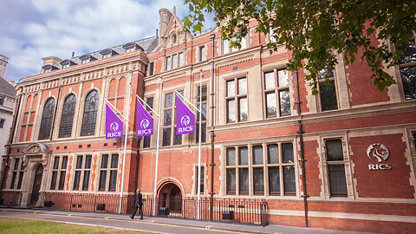Irene Barclay (1894-1989)
The first woman chartered surveyor
An extended version of this article appeared in the RICS Land Journal August/September 2017, pp24-26 and the RICS Building Control Journal, September/October 2017, pp16-17 and there is also an entry in the Oxford Dictionary of National Biography.
What opened the door for women to join the profession?
The Sex Disqualification (Removal) Act 1919 lifted the bar on women entering certain professions, largely following the social, political and economic fall-out of the 1914-18 War, but also after considerable lobbying in the wake of Bebb v Law Society [1913] where, famously, women were deemed not to be ‘people’ under the Solicitors Act 1843. Before this, women had qualified in related fields, such as Women Housing Property Managers, but not as chartered surveyors.
Who was the first woman chartered surveyor?
Mrs Irene Barclay, née Martin. Irene Turberville Martin was born into a socialist family in Hereford in 1894. Her father, Basil, was a non-conformist minister whose memoirs, An Impossible Parson (1935), set out the philosophy of public service, faith and wry sense of fun which informed her upbringing. Barclay (to use her married name) was the eldest of four. Her brother, Kingsley, was an occasional lecturer in politics at the LSE, a committed pacifist, and editor of The New Statesman from 1930 to 1960. Barclay attended Hereford High School, which she loved, until 1911. She then boarded at Monmouth High for two years, where she was ‘miserable in the extreme’. Having grown up in reasonable comfort, in 1913 the family moved to Finchley in somewhat straightened circumstances, although the tertiary education which followed was a happier experience. Barclay and her siblings all referred to secondary schooling in negative terms, their inherited religious and political free thinking perhaps not sitting well in early twentieth century provincial England. Barclay gained a 1st class degree in History in 1916 followed by a diploma in Social Science in 1917, both from Bedford College (University of London).
What led a history graduate into surveying?
Work experience during Barclay’s Social Science diploma introduced her to London’s slums. At this time she met Miss Maud Jeffery, a housing manager for the Crown Estate Commissioners. Miss Jeffery ensured that Barclay became an early member of the Association of Women House Property Managers and encouraged her to study for surveying exams. So Barclay took evening classes in surveying alongside Evelyn Perry, the second woman to be admitted, and they referred, with ill-concealed mischief, to tutors’ embarrassment at having women present in lectures on drainage and sanitation. She was employed throughout her training period by the Crown Office on a salary which reached £140 per year by the time she left - ‘stingy’ (in Barclay’s word) even by contemporary measures. Irene Martin passed her examinations to qualify in the Valuation Division in May 1922 and was admitted in the November of that year.
How did her career progress once qualified?
On qualification, Barclay spent six months with Louis de Soissons, architect of the new Welwyn Garden City, but she soon set up in on her own account in Finsbury Square. She ran the practice, largely in partnership with Evelyn Perry, in Somers Town (the area around St Pancras, King’s Cross and Euston stations), for over 50 years.
Housing association work
Barclay’s working life was spent improving London social housing and, along with her private practice, she was involved from the earliest days with the St Pancras Housing Association (now Origin Housing), becoming Secretary of the Society in 1925, holding the office for 48 years.
The Society’s first project was to purchase and refurbish seven houses. Barclay later favoured demolition and re-development over refurbishment once the extent of damp, dry rot, poor structure and, not least, bed bug infestation, became apparent. A key feature of housing association developments managed by Barclay and Perry, which distinguished them from council programmes, was re-housing within communities, to retain community bonds, an ethos reflected in the title of her record of working and, to some extent, personal life, People Need Roots (1976). Barclay and her partner also achieved some of their success through shrewd financial management, for example running an in-house workforce for general maintenance, only sub-contracting large structural programmes, even then ensuring that all materials were purchased direct.
Along with St Pancras work, Barclay’s firm took on the establishment and management of other housing associations, council estate management, private professional work and some voluntary activities. And she led the support of tenants in their struggles with landlords and loan sharks, setting up a loan club and furniture shop. In addition, Barclay and her colleagues worked to provide accommodation for the elderly, nurseries, play areas, seaside holidays and a children’s home in the country, her deep compassion and politics always manifest in practical measures.
In the decades of mass slum clearance, Barclay and Perry broke new ground with their surveys, commissioned both privately and by local authorities, which were unique in the extent of internal surveying and engagement with residents, as opposed to the more cursory, external surveys more usually produced by councils. This not only gained tenants’ support but provided depth to discussions of housing need.
Public life
Barclay was a prolific speaker, broadcaster and writer, often for the left-wing press such as the Fabian Quarterly or the New Statesman. Writing and speaking invitations increased considerably on the publication of the influential war-time report, Our Towns: a Close-up, produced in 1943 by the Women’s Group on Public Welfare (of which she was a member) at the request of the National Federation of Women’s Institutes when evacuation disclosed the hygiene, nutrition and behavioural standards of small proportion of evacuees to be of concern. She also edited the annual property journal House Happenings for some time after the war.
After the war Barclay continued to campaign for better housing and joined a number of public committees and boards, expressing the hope that she was chosen as a surveyor and not as a token woman!
Networking and professional associations
Barclay expressed sorrow at the lack of time in her early career and war years to keep up with professional and networking groups: the Soroptomists, the Society of Women Housing Managers (SWHM) and, of course the Surveyors’ Institution (now the RICS). At the end of the war, however, she became chairman of the SWHM and drove the dropping of the ‘W’ and the introduction of men.
Family life
Unlike many career women in the first half of the twentieth century, Barclay married and had two sons, Michael and Anthony. Her husband, John (1897-1966), had been invalided out of the First World War and was imprisoned for his radical pacifism in the Second and was the subject of an episode of the television programme, This Is Your Life. Involved with the cooperative movement, he co-founded the Peace Pledge Union and the Dutch Relief Scheme - like his wife, dedicated to a life of public service.
Recognition
In 1966 Barclay was widowed and received on OBE for her work with housing associations. She retired in 1972 and died in Toronto in 1989, having moved to Canada a few years earlier to be near her younger son. She is commemorated by name in Irene Barclay House, in Eversholt Street, her name is still on a sign stipulating no cycling or ball games, on one of the estates and there is, as at March 2022, a campaign to get a blue plaque erected.
How many women surveyors are there today?
In dramatic divergence from the legal and medical professions, which are now comprised of up to or over 50% women (in the lower rungs of the career ladder, at least), in surveying it is still less than 20%, a fact which would, doubtless, surprise and disappoint Irene Barclay, who qualified a century ago.
And why so few?
There would seem to be no express barriers today but among the explanations might be:
(a) the same reason why not enough men choose the profession; that is a lack of knowledge of the profession among school, college and university students, not to mention careers’ advisers; and
(b) a self-fulfilling perception that many branches of the profession are male dominated, thus young women may feel less comfortable in all male offices on work experience, or through the lack of role models and, conversely, some (certainly not all) of the men in those offices, may be less than welcoming to women.
It must be noted, that gender is not the only under-represented feature of the surveying demographic and colour, disability and class/background all need addressing if the profession is to gain the strength in numbers and perspectives which are needed for sustainability and for maximising the benefits to all, because surveying is, uniquely, a profession which impacts everyone every day as we live and work and play in the built and natural environment which is planned, designed, valued, marketed and managed by surveyors.
© 2022, Professor Carrie de Silva
Royal Agricultural University










